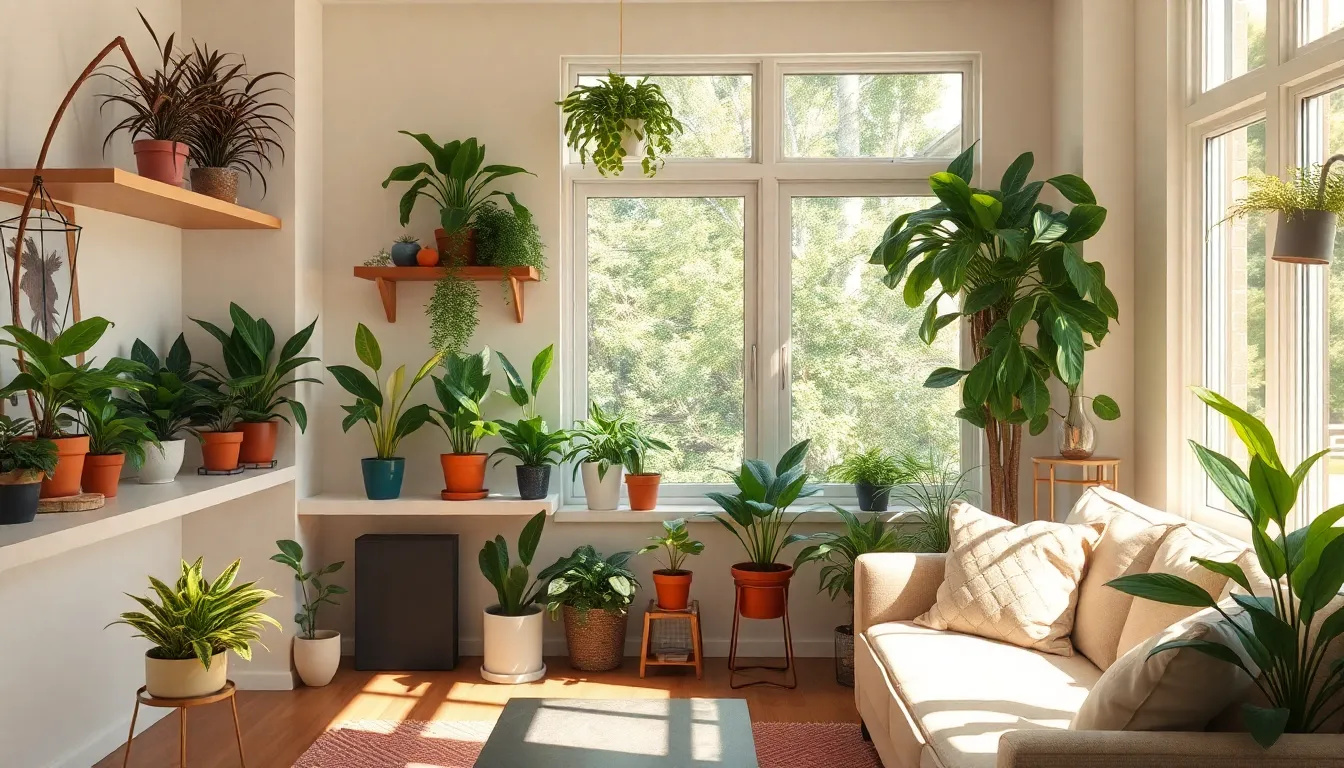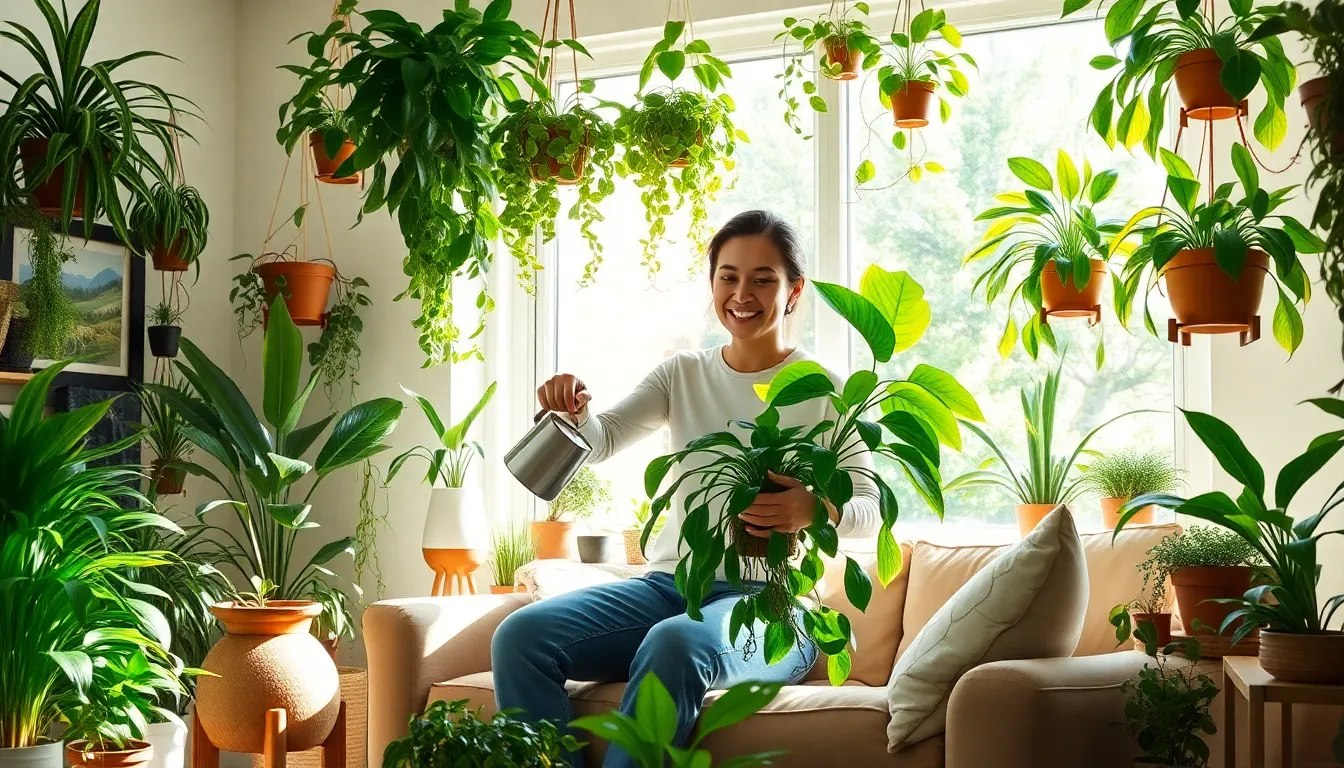In a world where houseplants are the new pets, creating a plant-friendly home has never been more essential. Imagine a space where your leafy companions thrive, soaking up sunlight and spreading joy, all while you bask in the glory of your indoor jungle. It’s like having a green thumb without the risk of being chased by a rogue cactus!
Table of Contents
ToggleWhat Are Plant-Friendly Homes?
Plant-friendly homes prioritize the well-being of houseplants. These spaces are designed to provide the ideal conditions for plants to thrive. Natural light plays a key role in these environments, as many houseplants require adequate sunlight to grow.
Ventilation also contributes to a plant-friendly atmosphere. Fresh air circulation helps maintain healthy humidity levels, preventing mold and pests. Soil health is equally important, as high-quality potting mix supports robust root systems and nutrient intake.
Furniture arrangement impacts light access. Placing plants near windows maximizes exposure to sunlight, encouraging growth. Utilizing shelves or hanging planters can further increase plant visibility and accessibility.
The selection of houseplants should reflect the home’s environment. Certain species thrive in low-light areas, while others prefer bright, direct sunlight. Choosing the right plants for each room creates a harmonious balance between aesthetics and functionality.
Maintaining a consistent watering schedule is essential in a plant-friendly home. Overwatering can lead to root rot, while underwatering can cause wilting. Monitoring moisture levels in the soil helps ensure plants stay healthy.
Incorporating natural materials in the decor can enhance the plant-friendly vibe. Wood, stone, and organic fibers complement the greenery, creating a tranquil ambiance. Additionally, using non-toxic materials promotes a safe environment for both plants and pets.
A plant-friendly home not only supports the growth of houseplants but also enriches the living space. Vibrant foliage brings life and color indoors while improving air quality. Creating such an environment fosters a sense of well-being for the occupants.
Benefits of Plant-Friendly Homes

Plant-friendly homes offer numerous advantages that enhance both the living environment and the well-being of its occupants. Benefits range from improved air quality to enhanced aesthetics and boosted mental health.
Improved Air Quality
Plants actively filter pollutants from the air, improving indoor air quality significantly. Studies show that houseplants can reduce levels of carbon dioxide, formaldehyde, and benzene. Specific plants, like spider plants and peace lilies, excel at removing toxins. Breathing in cleaner air contributes to better respiratory health. Homeowners often notice a reduction in allergies, thanks to the air-purifying abilities of houseplants.
Enhanced Aesthetics
A lush array of houseplants transforms any space into a vibrant oasis. Varying sizes and colors create dynamic visual interest. Strategically placing plants can draw attention to unique architectural features and brighten up dull corners. Incorporating greenery helps blend indoor and outdoor spaces, creating a soothing atmosphere. Home decorators frequently cite plants as essential elements for achieving a warm and inviting environment.
Boosting Mental Health
Surrounding oneself with plants can have a positive impact on mental health. Research indicates that exposure to greenery can reduce stress and anxiety levels. Many individuals find tasks like watering and pruning to be therapeutic. Plants encourage mindfulness and provide a sense of purpose. Enhancing well-being comes from the calming presence of nature within the home.
Key Features of Plant-Friendly Homes
Plant-friendly homes thrive on specific characteristics that nurture plant health and enhance indoor environments. Key features include optimal lighting conditions and proper ventilation.
Optimal Lighting Conditions
Natural sunlight significantly influences plant growth. High light levels create ideal photosynthesis conditions, impacting plant health. Incorporating large windows greatly improves light access, while sheer curtains diffuse strong sunlight effectively. Placement of plants near windows ensures they receive adequate light, meeting their specific light requirements. Different plants also reflect varying light preferences, so understanding their needs maximizes growth potential. Utilizing grow lights supplements insufficient natural light during darker months, ensuring year-round health for houseplants.
Proper Ventilation
Ventilation plays a crucial role in maintaining plant well-being. Fresh air circulation prevents mold growth and promotes healthy transpiration. Opening windows regularly enhances airflow, allowing plants to thrive. Incorporating fans can also improve air movement, particularly in rooms where stagnant air tends to collect. Additional humidity from plants can increase moisture levels, which is beneficial, but only if balanced with proper ventilation. Maintaining a consistently fresh environment ultimately supports plant vitality and contributes to overall home health.
Tips for Creating a Plant-Friendly Home
Creating a plant-friendly home requires thoughtfulness in plant selection and integration into living spaces. Emphasizing comfort and vitality enhances both plant health and home ambiance.
Choosing the Right Plants
Selecting the right plants is crucial. Consider factors such as light, humidity, and temperature when choosing species. Low-light plants like snake plants and pothos adapt well to various environments. High humidity-loving plants, such as ferns, thrive in bathrooms or kitchens. Researching plant care needs helps prevent common issues like overwatering or pests. Also, pairing plants with similar light requirements maximizes growth and minimizes care efforts.
Incorporating Greenery in Design
Integrating greenery into home design creates a harmonious atmosphere. Using decorative pots and unique stands adds visual appeal. Hang plants from ceiling hooks to draw the eye upward and save space. Shelves filled with plants can transform walls into living art. Arranging plants at varying heights enhances depth and interest in any room. Additionally, creating a dedicated corner for a plant collection forms a cozy, inviting focal point that encourages relaxation.
Creating a plant-friendly home is more than just a trend; it’s a lifestyle choice that brings numerous benefits. By prioritizing natural light and proper ventilation, individuals can cultivate a vibrant indoor garden that enhances their living spaces. Thoughtful plant selection and strategic arrangements not only beautify homes but also promote well-being through improved air quality and reduced stress.
Integrating houseplants into everyday life fosters a sense of connection to nature, transforming environments into serene oases. With a little care and attention, anyone can enjoy the therapeutic effects of greenery, making their home a healthier and more inviting place to be. Embracing this approach ultimately enriches both the space and the lives of its occupants.





